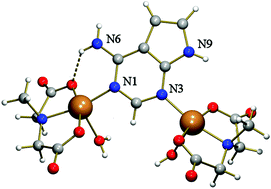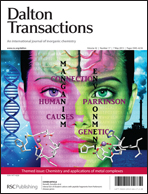For a better understanding of the versatile behaviour of adenine as a ligand, a series of 10 ternary copper(II) complexes with deaza-adenine ligands [7-azaindole (1,6,7-trideaza-adenine, H7azain), 4-azabenzimidazole (1,6-dideaza-adenine, H4abim), 5-azabenzimidazole (3,6-dideaza-adenine, H5abim), and 7-deaza-adenine (H7deaA)] have been synthesised and characterised by X-ray diffraction. Likewise, all the compounds studied have been analysed by spectral and thermal methods. The proton tautomers and donor capabilities of the above-mentioned deaza-adenine ligands have been calculated by DFT. We conclude that the increasing presence of N-donors in deaza-adenine ligands favours the proton tautomerism and their versatility as co-ligands. Notably, H7azain consistently uses the same tautomer, H4abim uses two different tautomers but is not protonated by the pentadentate H2EDTA2− ligand, and H(N1)5abim displays the μ2-N7,N9 mode, whereas H(N9)7deaA binds Cu(II) by N3 in cooperation with an intra-molecular N9–H⋯O interaction or using the unprecedented bidentate μ2-N1,N3 bridging mode.


 Please wait while we load your content...
Please wait while we load your content...